Jean de Brunhoff's Histoire de Babar Maquette
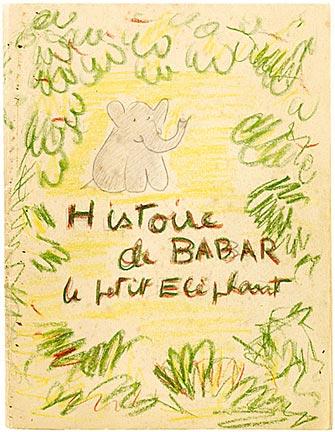
This digital facsimile presents every page of a small, delicate maquette that Jean de Brunhoff created in 1930 or 1931 as he drafted the first book in the Babar series. The maquette, an extraordinary handmade booklet complete with cover and endpapers, text and illustrations, is the prototype for Histoire de Babar, le petit éléphant.
The maquette is written on Johannot et Cie Annonay paper cut down to a page size of 8 1/8 x 6 1/8 inches (20.5 x 15.5 cm) and folded to approximate a book. In some cases de Brunhoff wrote on separate sheets and then pasted them into the maquette, obscuring earlier drafts he had made on the versos. Written and illustrated primarily in graphite, the maquette includes a few watercolor touches and a cover colored in green, yellow, and red crayon. On separate sheets of paper of the same type and size, de Brunhoff also made eleven pages of notes on color choices for his final illustrations.
After he completed the maquette, de Brunhoff returned to his sketchbooks and made significant changes that are reflected in the published book. He continued to revise the text, added a page showing Babar studying with a learned tutor, and, most importantly, subjected the opening and closing of the story to a major overhaul. The maquette opens with the death of Babar's mother; however, de Brunhoff ultimately decided to add a tender three-page opening sequence showing the infant Babar in a hammock and a group of young elephants playing. And while the maquette concludes abruptly with the marriage and coronation of Babar and Celeste, the published book ends with the newly married couple reflecting on their good fortune before taking off for their honeymoon in a yellow balloon.
The maquette is part of a collection of drafts and drawings for Histoire de Babar acquired by The Morgan Library & Museum in 2004 as the gift of Laurent, Mathieu, and Thierry de Brunhoff and purchased with the assistance of The Florence Gould Foundation and the Acquisitions Fund, Fellows Endowment Fund, Gordon N. Ray Fund, and Heineman Fund.
Thumbnails
Cover
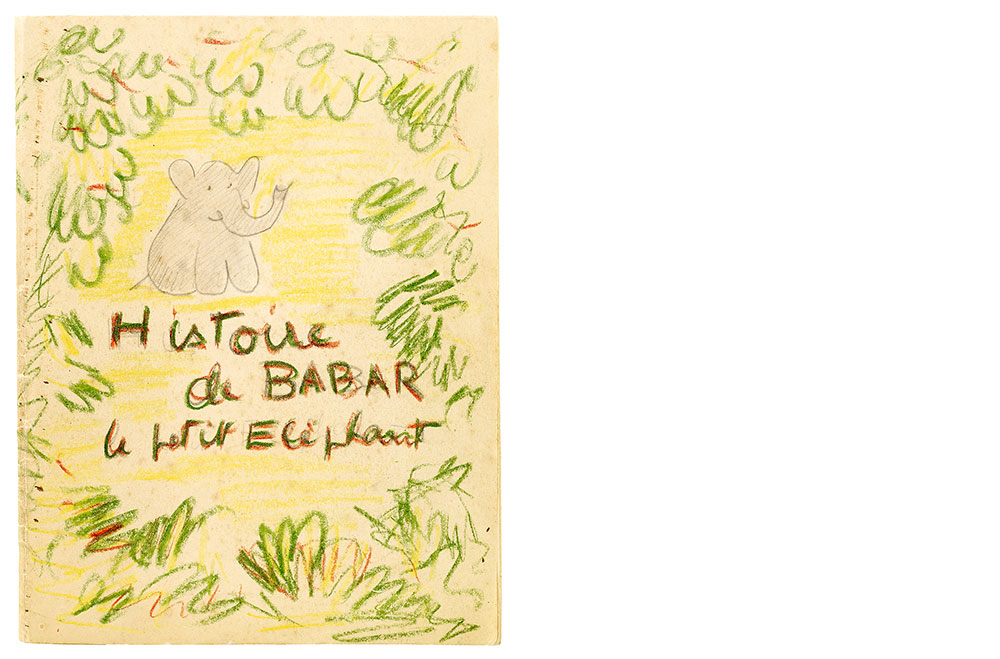
Histoire de Babar, le petit éléphant (The Story of Babar), Maquette
Gift of Laurent, Mathieu, and Thierry de Brunhoff, and purchased with the assistance of The Florence Gould Foundation and the Acquisitions Fund, Fellows Endowment Fund, Gordon N. Ray Fund, and the Heineman Fund, 2004
The Story of Babar, the Little Elephant
Histoire de Babar le petit éléphant

Jean de Brunhoff / Histoire de Babar / le petit éléphant / Editions du Jardin des Modes / Publications Condé Nast / 44 rue St Florentin / Paris
Jean de Brunhoff / The Story of Babar, the Little Elephant / Jardin des Modes Editions / Condé Nast Publications / 44 St. Florentin Street / Paris
Endpaper 1
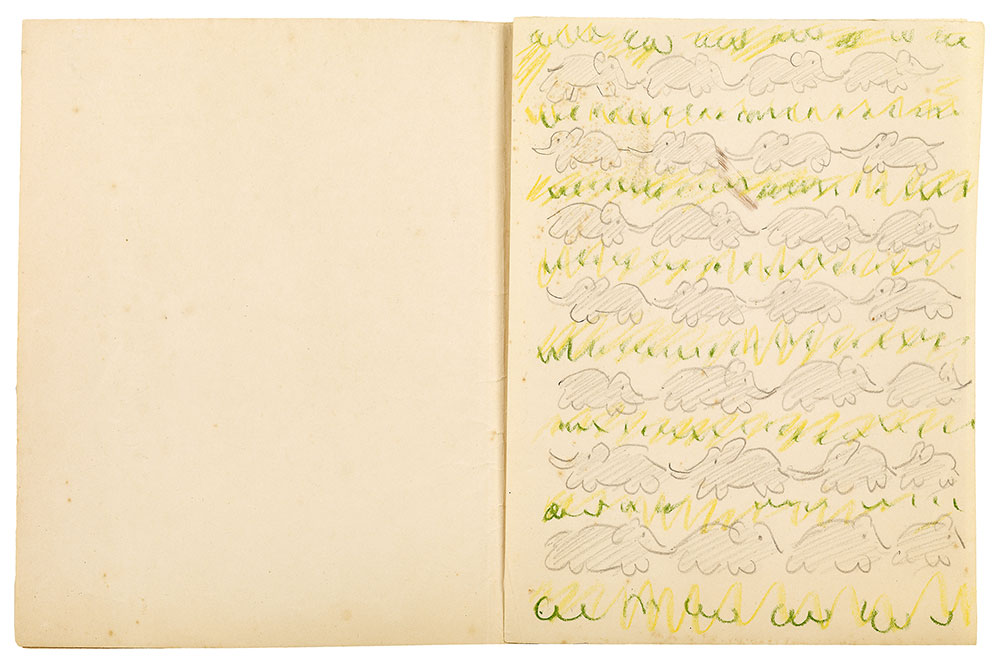
Histoire de Babar, le petit éléphant (The Story of Babar), Maquette
Gift of Laurent, Mathieu, and Thierry de Brunhoff, and purchased with the assistance of The Florence Gould Foundation and the Acquisitions Fund, Fellows Endowment Fund, Gordon N. Ray Fund, and the Heineman Fund, 2004
This is Jean de Brunhoff's first sketch for the memorable endpapers of Histoire de Babar, which depict a chain of elephants, linked trunk to tail, trekking in orderly fashion down the page. For the endpapers of the published book, he decided to eliminate the grassy background and introduce perspective, creating the illusion that the elephants are approaching the reader. This endpaper design was so successful that it has been used, with some variation in color and layout, in nearly all subsequent books in the series.
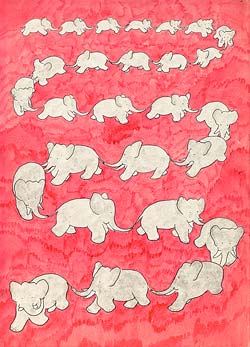
Endpaper 2
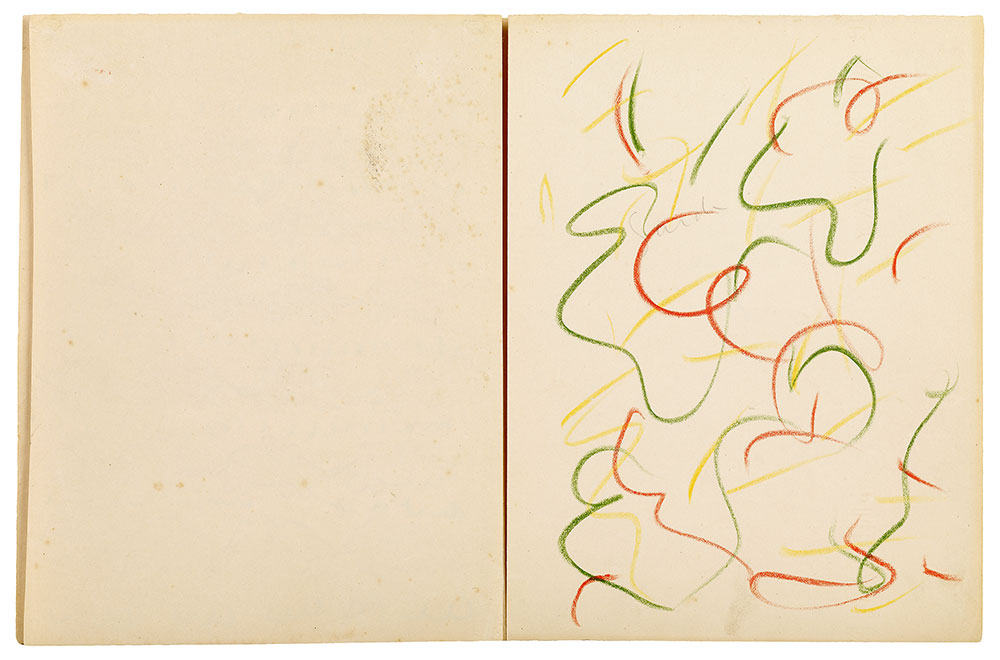
Histoire de Babar, le petit éléphant (The Story of Babar), Maquette
Gift of Laurent, Mathieu, and Thierry de Brunhoff, and purchased with the assistance of The Florence Gould Foundation and the Acquisitions Fund, Fellows Endowment Fund, Gordon N. Ray Fund, and the Heineman Fund, 2004
Jean de Brunhoff's maquette included a few pages of abstract patterns in green, red, and yellow—perhaps alternate endpapers or color trials—that resembled the curves and loops of cursive script. He drew this page using the limited palette—green, red, and yellow—that he had chosen for the book's illustrations. This page of the maquette was not incorporated in the published edition.
Half title page
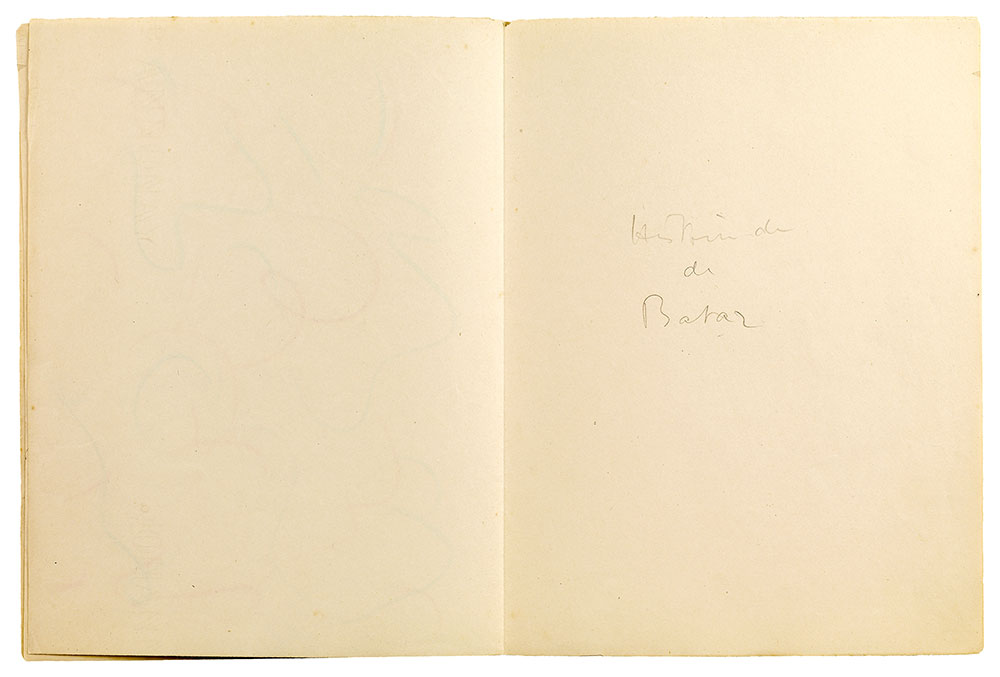
Histoire de Babar, le petit éléphant (The Story of Babar), Maquette
Gift of Laurent, Mathieu, and Thierry de Brunhoff, and purchased with the assistance of The Florence Gould Foundation and the Acquisitions Fund, Fellows Endowment Fund, Gordon N. Ray Fund, and the Heineman Fund, 2004
The Story of of [sic] Babar
Histoire de de [sic] Babar
Title page
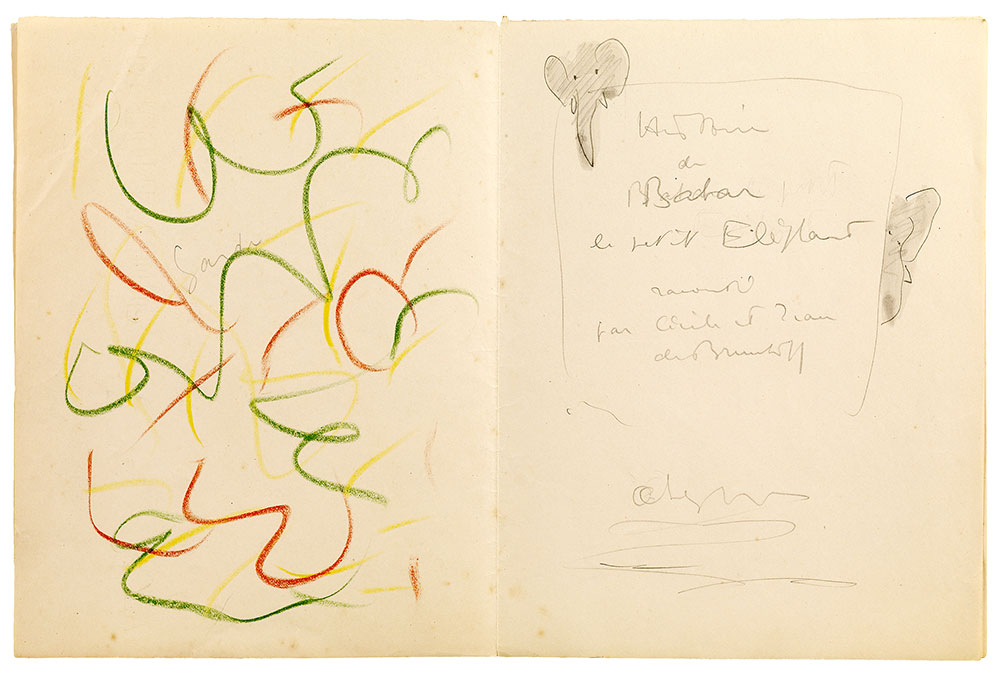
Histoire de Babar, le petit éléphant (The Story of Babar), Maquette
Gift of Laurent, Mathieu, and Thierry de Brunhoff, and purchased with the assistance of The Florence Gould Foundation and the Acquisitions Fund, Fellows Endowment Fund, Gordon N. Ray Fund, and the Heineman Fund, 2004
The Story of Babar, the Little Elephant / told by Cecile and Jean de Brunhoff / our place [or Chessy?]
Histoire de Babar le petit Eléphant / raconté par Cécile et Jean de Brunhoff / chez nous [or Chessy?]
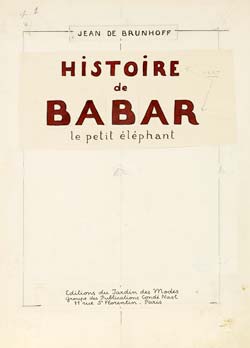
Jean de Brunhoff / Histoire de Babar le petit Eléphant / Editions du Jardin des Modes / Groupe des Publications Condé Nast / 44 rue St Florentin / Paris
Jean de Brunhoff / The Story of Babar, the Little Elephant / Jardin des Modes Editions / Condé Nast Publishing Group / 44 St Florentin Street / Paris
Page 1
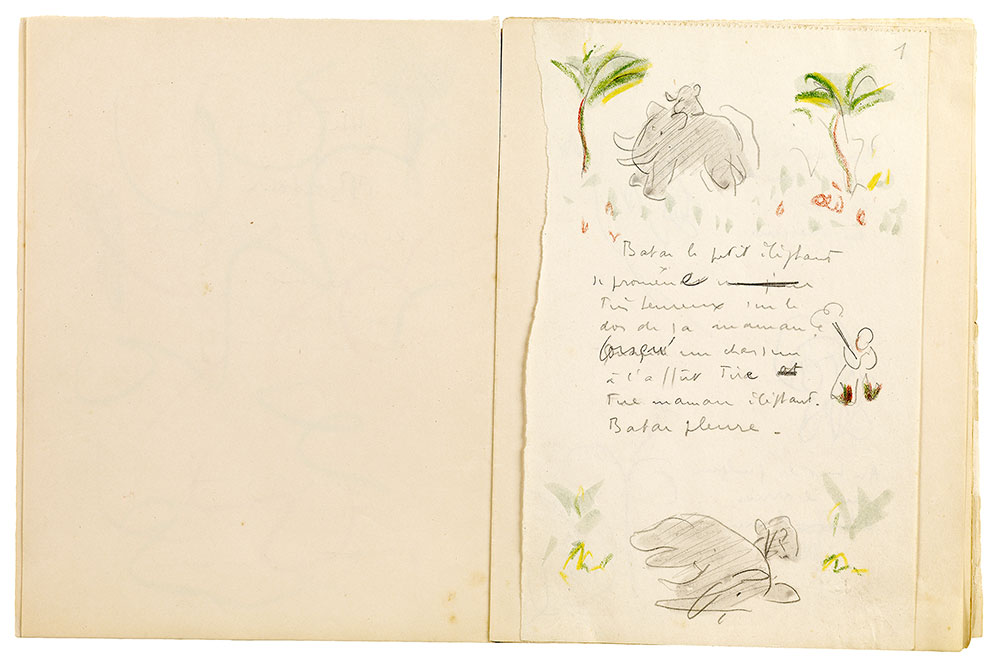
Histoire de Babar, le petit éléphant (The Story of Babar), Maquette
Gift of Laurent, Mathieu, and Thierry de Brunhoff, and purchased with the assistance of The Florence Gould Foundation and the Acquisitions Fund, Fellows Endowment Fund, Gordon N. Ray Fund, and the Heineman Fund, 2004
Babar the little elephant is riding happily on his mother's back one day when a hunter shoots from a blind and kills Mother Elephant. Babar cries.
Babar le petit éléphant se promène un jour très heureux sur le dos de sa maman quand lorsqu'un chasseur à l'affût tire et tue maman éléphant. Babar pleure.

Babar se promène très heureux sur le dos de sa maman, quand un vilain chasseur, caché derrière un buisson, tire sur eux. Le chasseur a tué la maman. Le singe se cache, les oiseaux s'envolent, Babar pleure. Le chasseur court pour attraper le pauvre Babar.
Babar is riding happily on his mother's back when a wicked hunter, hidden behind a bush, shoots at them. The hunter has killed Babar's mother. The monkey hides, the birds fly away, Babar cries. The hunter runs up to catch poor Babar.
Pages 2–3

Histoire de Babar, le petit éléphant (The Story of Babar), Maquette
Gift of Laurent, Mathieu, and Thierry de Brunhoff, and purchased with the assistance of The Florence Gould Foundation and the Acquisitions Fund, Fellows Endowment Fund, Gordon N. Ray Fund, and the Heineman Fund, 2004
Very sad indeed, Babar runs far away from the forest and from the hunter. After several days, he comes to a town. / He is amazed because this is the first time he has seen so many houses.
Babar tout triste se sauve loin de la forêt et du chasseur. Au bout de quelques jours il arrive près d'une ville. / Il est très étonné parce que c'est la première fois qu'il voit tant de maisons.

Babar se sauve parce qu'il a peur du chasseur. Au bout de quelques jours, bien fatigué, il arrive près d'une ville . . . / Il est très étonné parce que c'est la première fois qu'il voit tant de maisons.
Babar runs away because he is afraid of the hunter. After several days, very tired indeed, he comes to a town . . . / He is amazed because this is the first time that he has seen so many houses.
Pages 4–5
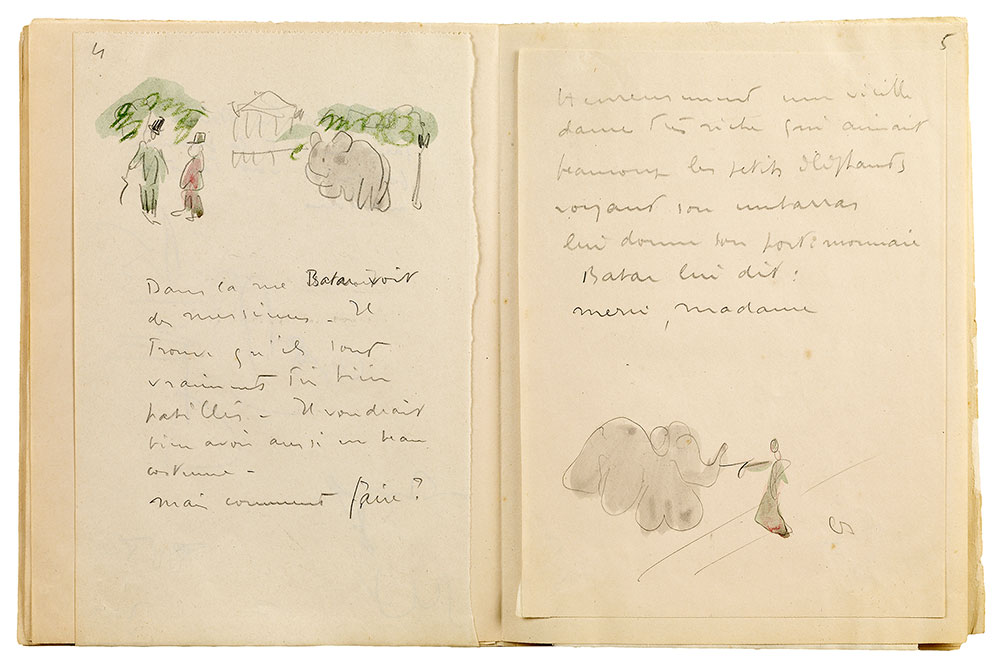
Histoire de Babar, le petit éléphant (The Story of Babar), Maquette
Gift of Laurent, Mathieu, and Thierry de Brunhoff, and purchased with the assistance of The Florence Gould Foundation and the Acquisitions Fund, Fellows Endowment Fund, Gordon N. Ray Fund, and the Heineman Fund, 2004
He sees Babar sees some gentlemen on the street. He thinks they are really very well dressed. He, too, would very much like to have such fine clothes—but how? can he do it? Luckily, a very rich old lady who has always been fond of little elephants sees his problem and gives him her purse. Babar says to her, "Thank you, ma'am."
Dans la rue il voit Babar voit des messieurs. Il trouve qu'ils sont vraiment très bien habillés. Il voudrait bien avoir aussi un beau costume—mais comment ? faire? / Heureusement une vieille dame très riche qui aimait beaucoup les petits éléphants voyant son embarras lui donne son porte-monnaie. Babar lui dit: " Merci, madame. "
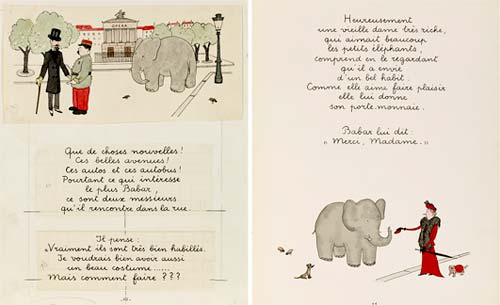
Que de choses nouvelles! Ces belles avenues! Ces autos et ces autobus! Pourtant ce qui intéresse le plus Babar, ce sont deux messieurs qu'il rencontre dans la rue. Il pense: « Vraiment ils sont très bien habillés. Je voudrais bien avoir aussi un beau costume. . . . » Mais comment faire??? / Heureusement une vieille dame très riche, qui aimait beaucoup les petits éléphants, comprend en le regardant qu'il a envie d'un bel habit. Comme elle aime faire plaisir elle lui donne son porte-monnaie. Babar lui dit: « Merci, Madame. »
So many things are new to him! The broad streets! The automobiles and buses! However, Babar is especially interested in two gentlemen he notices on the street. He says to himself: "Really, they are very well dressed. I would like to have some fine clothes, too. . . . " But how can he do it??? / Luckily, a very rich old lady who has always been fond of little elephants understands right away that he is longing for a fine suit. As she likes to make people happy, she gives him her purse. Babar says to her, "Thank you, ma'am."
Pages 6–7
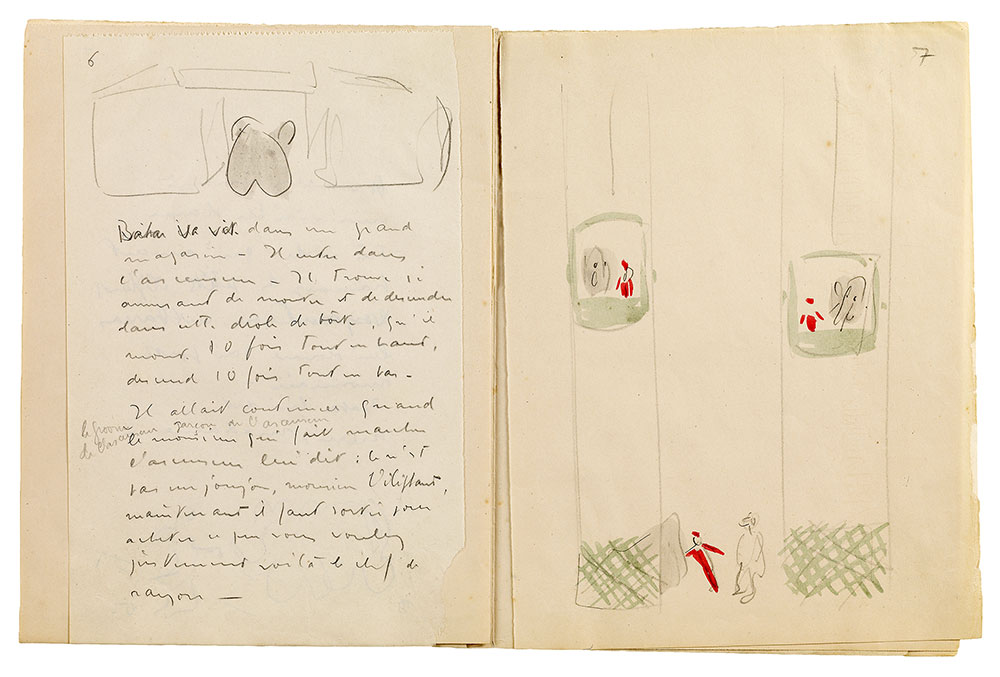
Histoire de Babar, le petit éléphant (The Story of Babar), Maquette
Gift of Laurent, Mathieu, and Thierry de Brunhoff, and purchased with the assistance of The Florence Gould Foundation and the Acquisitions Fund, Fellows Endowment Fund, Gordon N. Ray Fund, and the Heineman Fund, 2004
Quickly he goes Quickly Babar goes into a big store. He enters the elevator. It is such fun to ride up and down in this funny box that he goes all the way up 10 times and all the way down 10 times. He was going to continue when the man who runs elevator [inserted: the elevator operator, the elevator boy] says to him, "This is not a toy, Mr. Elephant. You must get out now and do your shopping. Look, here is the floorwalker."
Vite il va Babar va vite dans un grand magasin. Il entre dans l'ascenseur. Il trouve si amusant de monter et de descendre dans cette drôle de boîte, qu'il mont[e] 10 fois tout en haut, descend 10 fois tout en bas. Il allait continuer quand le monsieur [inserted: le groom de l'ascenseur, garçon de l'ascenseur] qui fait marcher l'ascenseur lui dit: "Ce n'est pas un joujou, monsieur l'éléphant, maintenant il faut sortir pour acheter ce que vous voulez. Justement voilà le chef de rayon."

Que de choses nouvelles! Ces belles avenues! Ces autos et ces autobus! Pourtant ce qui intéresse le plus Babar, ce sont deux messieurs qu'il rencontre dans la rue. Il pense: « Vraiment ils sont très bien habillés. Je voudrais bien avoir aussi un beau costume. . . . » Mais comment faire??? / Heureusement une vieille dame très riche, qui aimait beaucoup les petits éléphants, comprend en le regardant qu'il a envie d'un bel habit. Comme elle aime faire plaisir elle lui donne son porte-monnaie. Babar lui dit: « Merci, Madame. »
So many things are new to him! The broad streets! The automobiles and buses! However, Babar is especially interested in two gentlemen he notices on the street. He says to himself: "Really, they are very well dressed. I would like to have some fine clothes, too. . . . " But how can he do it??? / Luckily, a very rich old lady who has always been fond of little elephants understands right away that he is longing for a fine suit. As she likes to make people happy, she gives him her purse. Babar says to her, "Thank you, ma'am."
brunhoff_ma6304.10_p12-13.jpg" alt="" border="0" />
Sans perdre une minute Babar va dans un grand magasin. Il entre dans l'ascenseur. Il trouve si amusant de monter et de descendre dans cette drôle de boite, qu'il monte dix fois tout en haut, descend dix fois tout en bas. Il allait continuer quand le groom de l'ascenseur lui dit: «Ce n'est pas un joujou, monsieur l'éléphant, maintenant il faut sortir pour acheter ce que vous voulez, justement voilà le chef de rayon.»
Without wasting any time, Babar goes into a big store. He enters the elevator. It is such fun to ride up and down in this funny box, that he rides all the way up ten times and all the way down ten times. He was going to continue but the elevator boy finally says to him: "This is not a toy, Mr. Elephant. You must get out and do your shopping. Look, here is the floorwalker."
Pages 8–9
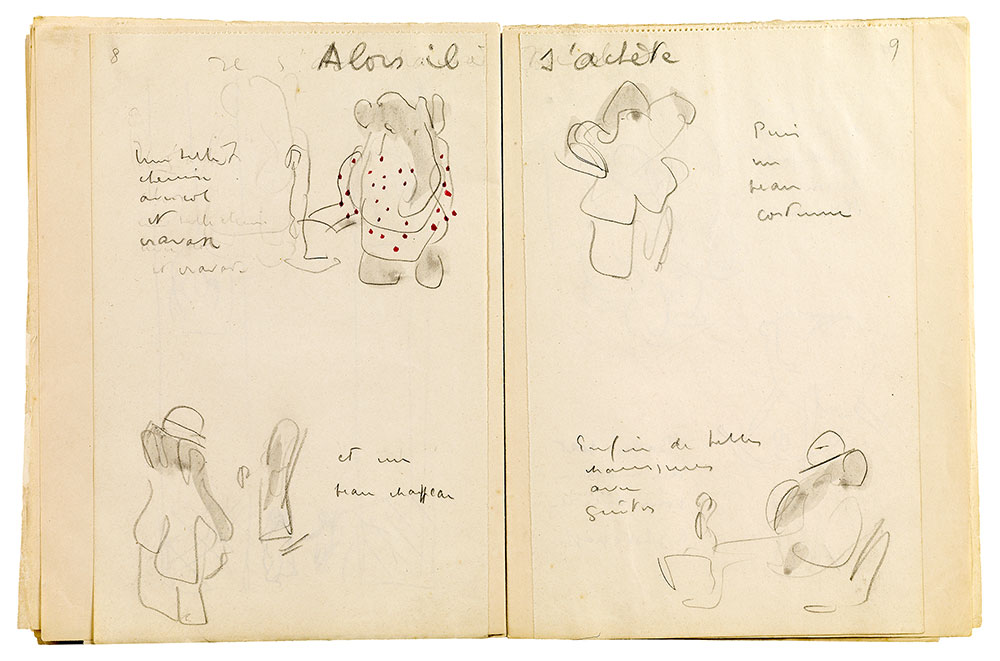
Histoire de Babar, le petit éléphant (The Story of Babar), Maquette
Gift of Laurent, Mathieu, and Thierry de Brunhoff, and purchased with the assistance of The Florence Gould Foundation and the Acquisitions Fund, Fellows Endowment Fund, Gordon N. Ray Fund, and the Heineman Fund, 2004
Then he buys himself a beautiful shirt with a collar and tie and a beautiful hat. Then a beautiful suit, and finally some beautiful shoes with spats.
Alors il s'achète une belle chemise avec col et cravate et un beau chapeau. Puis un beau costume. Enfin de belles chaussures avec guêtres.

Alors il s'achète: une chemise avec col et cravate, un costume d'une agréable couleur verte, puis un beau chapeau melon, enfin des souliers avec des guêtres.
Then he buys himself: a shirt with a collar and tie, a suit of a becoming shade of green, then a handsome derby hat, and finally shoes with spats.
Pages 10–11
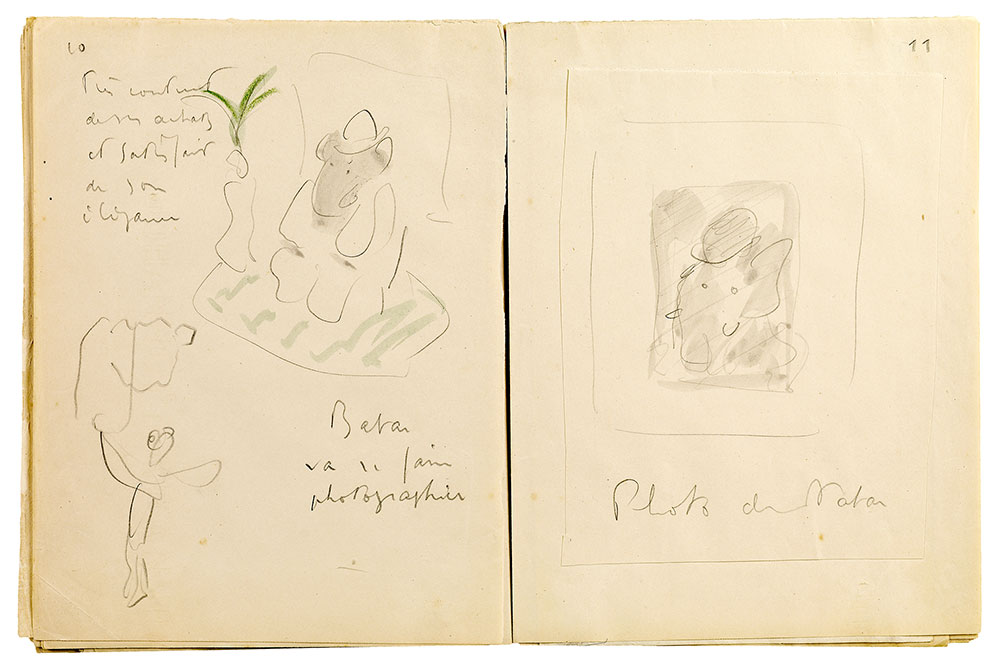
Histoire de Babar, le petit éléphant (The Story of Babar), Maquette
Gift of Laurent, Mathieu, and Thierry de Brunhoff, and purchased with the assistance of The Florence Gould Foundation and the Acquisitions Fund, Fellows Endowment Fund, Gordon N. Ray Fund, and the Heineman Fund, 2004
Well satisfied with his purchases and feeling very elegant indeed, Babar goes to have his photograph taken. / Photo of Babar
Très content de ses achats et satisfait de son élégance Babar va se faire photographier. / Photo de Babar
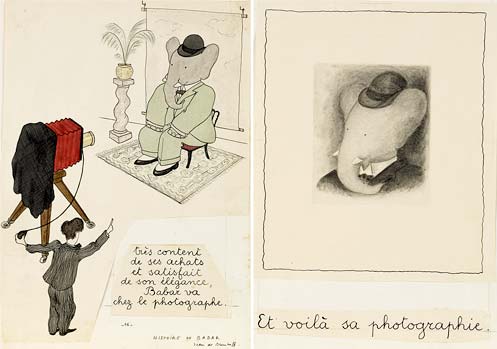
Très content de ses achats et satisfait de son élégance, Babar va chez le photographe. / Et voilà sa photographie.
Well satisfied with his purchases and feeling very elegant indeed, Babar goes to the photographer's studio. / And here is his photograph.
Pages 12–13
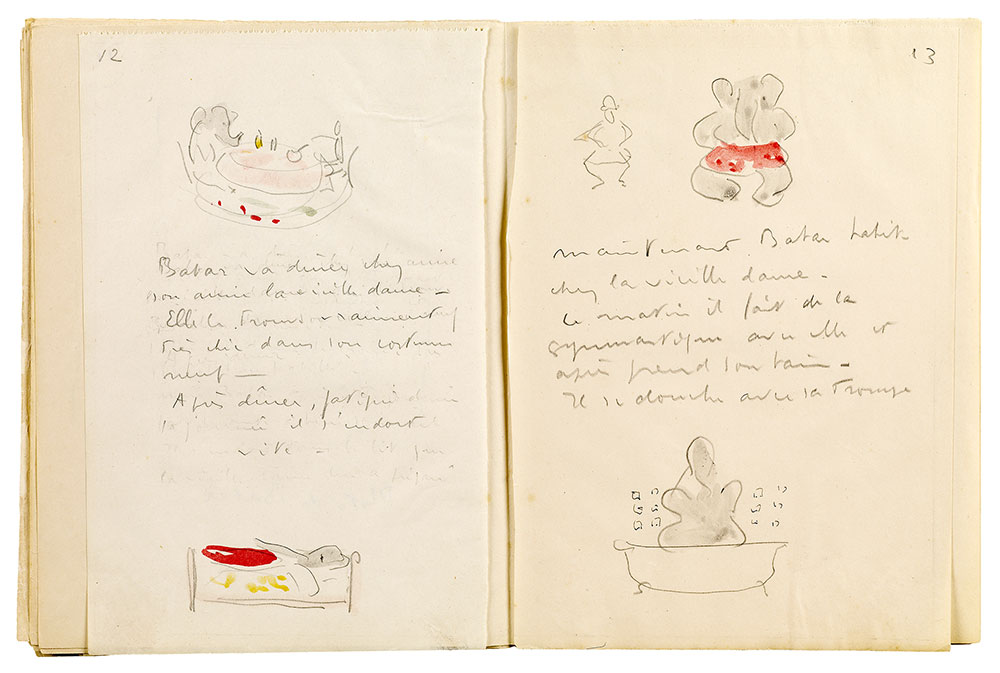
Histoire de Babar, le petit éléphant (The Story of Babar), Maquette
Gift of Laurent, Mathieu, and Thierry de Brunhoff, and purchased with the assistance of The Florence Gould Foundation and the Acquisitions Fund, Fellows Endowment Fund, Gordon N. Ray Fund, and the Heineman Fund, 2004
Babar dines with his friend, the Old Lady. She thinks he looks very smart in his new clothes. After dinner, feeling tired, he falls asleep quickly. / Babar now lives at the Old Lady's house. In the mornings he does exercises with her and then takes his bath. He showers with his trunk.
Babar va dîner chez son amie la vieille dame. Elle le trouve vraiment très chic dans son costume neuf. Après dîner, fatigué, il s'endort vite. / Maintenant Babar habite chez la vieille dame. Le matin il fait de la gymnastique avec elle et après prend son bain. Il se douche avec sa trompe.

Babar va dîner chez son amie la vieille dame. Elle le trouve très chic dans son costume neuf. Après le dîner, fatigué, il s'endort vite. / Maintenant Babar habite chez la vieille dame. Le matin, avec elle, il fait de la gymnastique, puis il prend son bain.
Babar dines with his friend the Old Lady. She thinks he looks very smart in his new clothes. After dinner, feeling tired, he falls asleep quickly. / Babar now lives at the Old Lady's house. In the mornings, he does exercises with her, and then he takes his bath.
Page 14–15
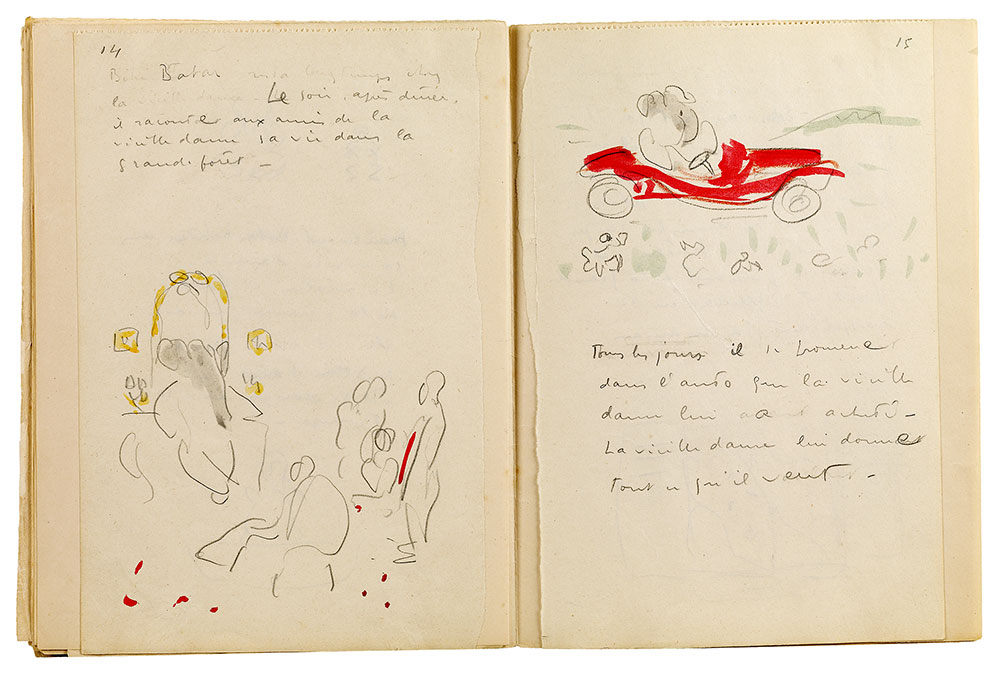
Histoire de Babar, le petit éléphant (The Story of Babar), Maquette
Gift of Laurent, Mathieu, and Thierry de Brunhoff, and purchased with the assistance of The Florence Gould Foundation and the Acquisitions Fund, Fellows Endowment Fund, Gordon N. Ray Fund, and the Heineman Fund, 2004
In the evening, after dinner, he tells the Old Lady's friends all about his life in the great forest. / Every day he goes for a ride in the car the Old Lady has bought for him. The Old Lady gives him whatever he wants.
Le soir après dîner, il raconte aux amis de la vieille dame sa vie dans la grande forêt. / Tous les jours il se promène dans l'auto que la vieille dame lui a acheté[e]. La vieille dame lui donne tout ce qu'il veut.
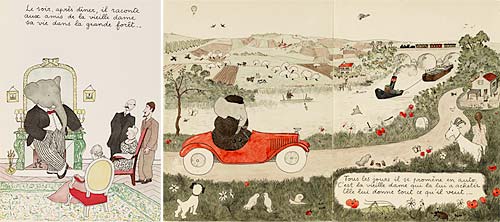
Le soir, après dîner, il raconte aux amis de la vieille dame sa vie dans la grande forêt. / Tous les jours il se promène en auto. C'est la vieille dame qui la lui a achetée. Elle lui donne tout ce qu'il veut.
In the evening, after dinner, he tells the Old Lady's friends all about his life in the great forest. / He goes out for an automobile ride every day. The Old Lady has bought him the car. She gives him whatever he wants.
Pages 16–17
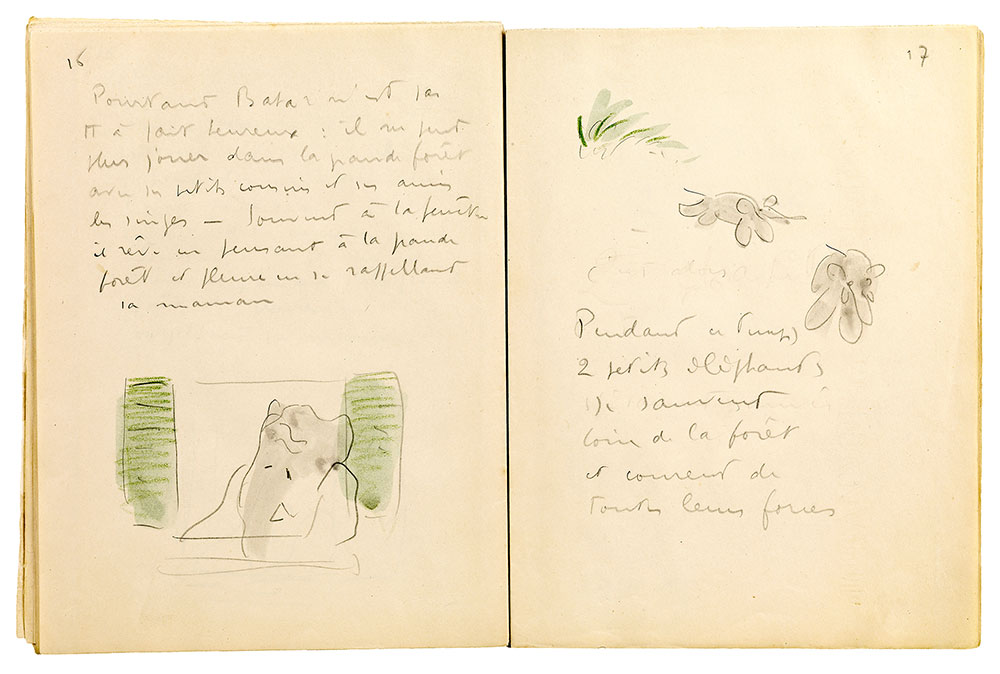
Histoire de Babar, le petit éléphant (The Story of Babar), Maquette
Gift of Laurent, Mathieu, and Thierry de Brunhoff, and purchased with the assistance of The Florence Gould Foundation and the Acquisitions Fund, Fellows Endowment Fund, Gordon N. Ray Fund, and the Heineman Fund, 2004
And yet Babar is not entirely happy: he can no longer play in the great forest with his little cousins and his friends, the monkeys. He often stands at the window thinking about the great forest, and he cries when he remembers his mother. / Meanwhile 2 little elephants escape faraway from the forest, running as fast as they can.
Pourtant Babar n'est pas t[ou]t à fait heureux: il ne peut plus jouer dans la grande forêt avec ses petits cousins et ses amis les singes. Souvent à la fenêtre il rêve en pensant à la grande forêt et pleure en se rappelant sa maman. / Pendant ce temps 2 petits éléphants se sauvent loin de la forêt et courent de toutes leurs forces.
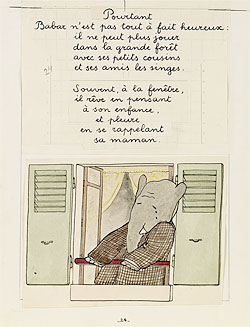
Pourtant Babar n'est pas tout à fait heureux: il ne peut plus jouer dans la grande forêt avec ses petits cousins et ses amis les singes. Souvent, à la fenêtre, il rêve en pensant à son enfance, et pleure en se rappelant sa maman.
And yet Babar is not entirely happy, for he can no longer play in the great forest with his little cousins and his friends, the monkeys. He often stands at the window, thinking of his childhood, and cries when he remembers his mother.
Note: p. 17 of the maquette does not appear in the published edition.
Pages 18–19
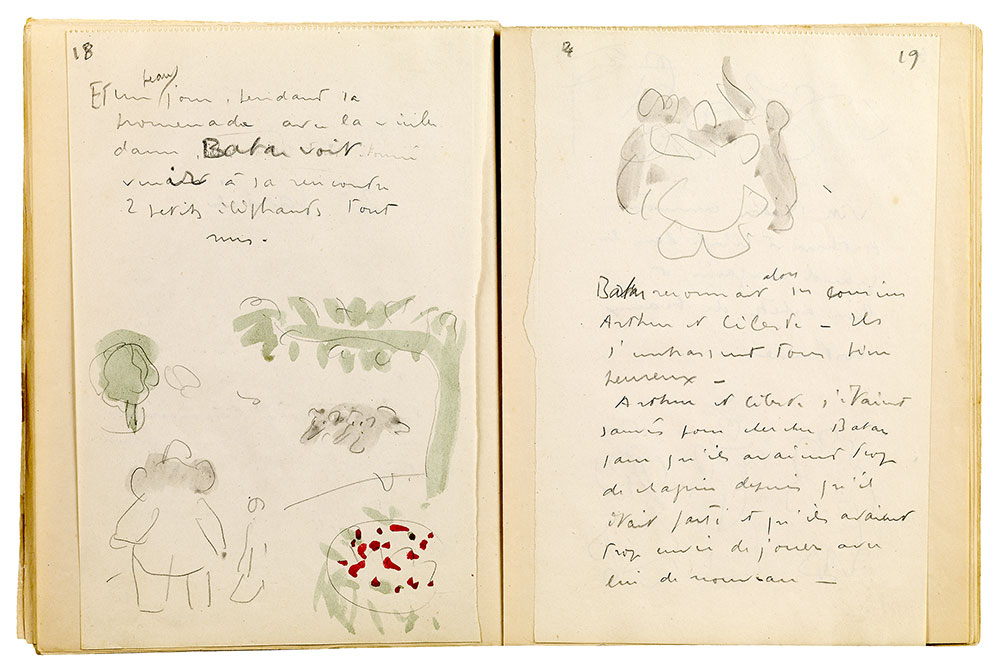
Histoire de Babar, le petit éléphant (The Story of Babar), Maquette
Gift of Laurent, Mathieu, and Thierry de Brunhoff, and purchased with the assistance of The Florence Gould Foundation and the Acquisitions Fund, Fellows Endowment Fund, Gordon N. Ray Fund, and the Heineman Fund, 2004
Et un beau jour, pendant la promenade avec la vieille dame, Babar voit venir à sa rencontre 2 petits éléphants tout nus. / Babar reconnaît alors ses cousins Arthur et Céleste. Ils s'embrassent tous bien heureux. Arthur et Céleste s'étaient sauvés pour chercher Babar parce qu'ils avaient trop de chagrin depuis qu'il était parti et qu'ils avaient trop envie de jouer avec lui de nouveau.
And one fine day, during his walk with the Old Lady, Babar sees 2 little elephants, completely naked, coming toward him. / Babar then recognizes his cousins Arthur and Celeste. They kiss each other joyously. Arthur and Celeste had run away to look for Babar because they were upset after he had left, and they wanted very much to play with him once again.
Et un beau jour, pendant la promenade avec la vieille dame, Babar voit venir à sa rencontre 2 petits éléphants tout nus. / Babar reconnaît alors ses cousins Arthur et Céleste. Ils s'embrassent tous bien heureux. Arthur et Céleste s'étaient sauvés pour chercher Babar parce qu'ils avaient trop de chagrin depuis qu'il était parti et qu'ils avaient trop envie de jouer avec lui de nouveau.
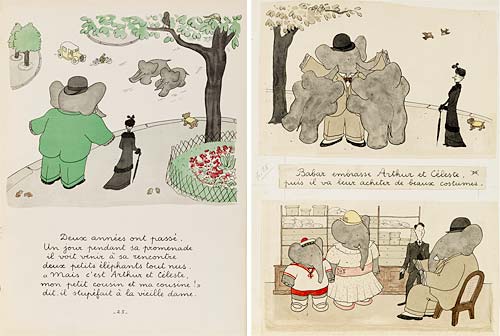
Deux années ont passé. Un jour pendant sa promenade il voit venir à sa rencontre deux petits éléphants tout nus. «Mais c'est Arthur et Céleste, mon petit cousin et ma cousine!» dit-il stupéfait à la vieille dame. / Babar embrasse Arthur et Céleste puis il va leur acheter de beaux costumes.
Two years have passed. One day during his walk he sees two little elephants, completely naked, coming toward him. "Why," he says in astonishment to the Old Lady, "it's Arthur and Celeste, my little cousins!" / Babar kisses Arthur and Celeste and goes to buy them some fine clothes.
Pages 20–21
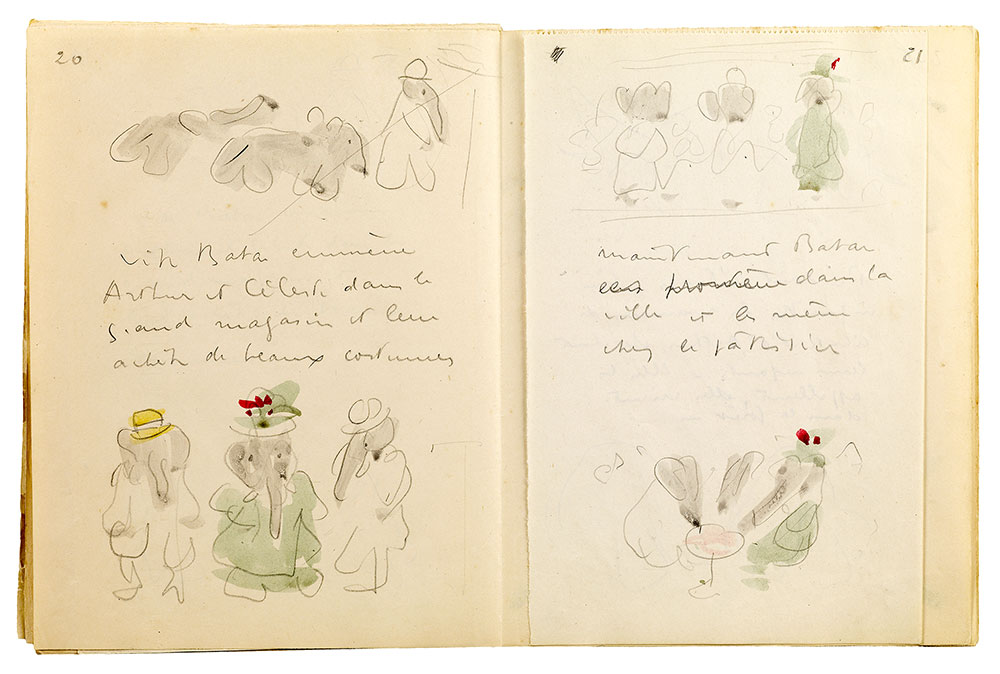
Histoire de Babar, le petit éléphant (The Story of Babar), Maquette
Gift of Laurent, Mathieu, and Thierry de Brunhoff, and purchased with the assistance of The Florence Gould Foundation and the Acquisitions Fund, Fellows Endowment Fund, Gordon N. Ray Fund, and the Heineman Fund, 2004
Babar hurries to take Arthur and Celeste to the big store and buys them some fine clothes. / Then Babar shows them takes them into town and into the pastry shop.
Vite Babar emmène Arthur et Céleste dans le grand magasin et leur achète de beaux costumes. / Maintenant Babar leur montre les promène dans la ville et les mène chez le pâtissier.
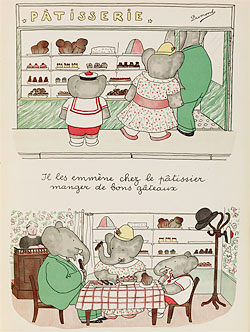
Il les emmène chez le pâtissier manger de bons gâteaux.
He takes them to a pastry shop to eat some delicious cakes.
Pages 22–23
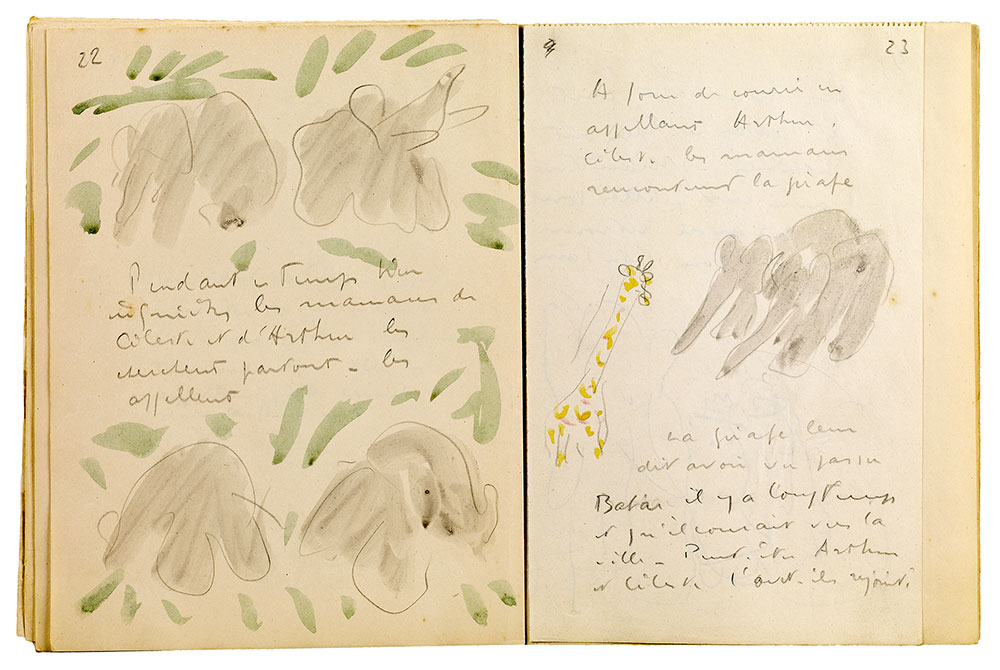
Histoire de Babar, le petit éléphant (The Story of Babar), Maquette
Gift of Laurent, Mathieu, and Thierry de Brunhoff, and purchased with the assistance of The Florence Gould Foundation and the Acquisitions Fund, Fellows Endowment Fund, Gordon N. Ray Fund, and the Heineman Fund, 2004
Meanwhile, Celeste's and Arthur's mothers, feeling very worried, search everywhere for them, calling out their names. / After running and calling "Arthur, Celeste" for awhile, the mothers run into the giraffe. The giraffe tells them that he saw Babar go by a long time ago and that he was running toward town. Perhaps Arthur and Celeste have met up with him?
Pendant ce temps, bien inquiètes, les mamans de Céleste et d'Arthur les cherchent partout [et] les appellent. / A force de courir en appellant [i.e., appelant] "Arthur, Céleste" les mamans rencontrent la girafe. La girafe leur dit avoir vu passer Babar il y a longtemps et qu'il courait vers la ville. Peut-être Arthur et Céleste l'ont-ils rejoint?
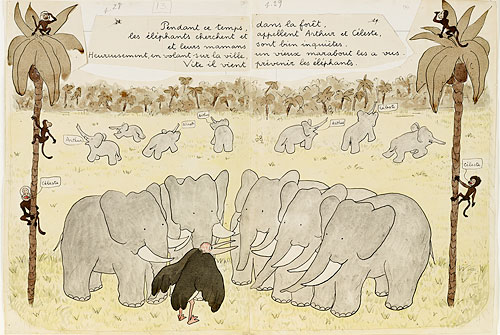
Pendant ce temps dans la forêt, les éléphants cherchent et appellent Arthur et Céleste, et leurs mamans sont bien inquiètes. Heureusement, en volant sur la ville, un vieux marabout les a vus. Vite il vient prévenir les éléphants.
Meanwhile, in the forest, the elephants are calling and hunting for Arthur and Celeste, and their mothers are very worried. Fortunately, in flying over the town, an old marabou has seen them. He comes back quickly to tell the elephants.
Pages 24–25
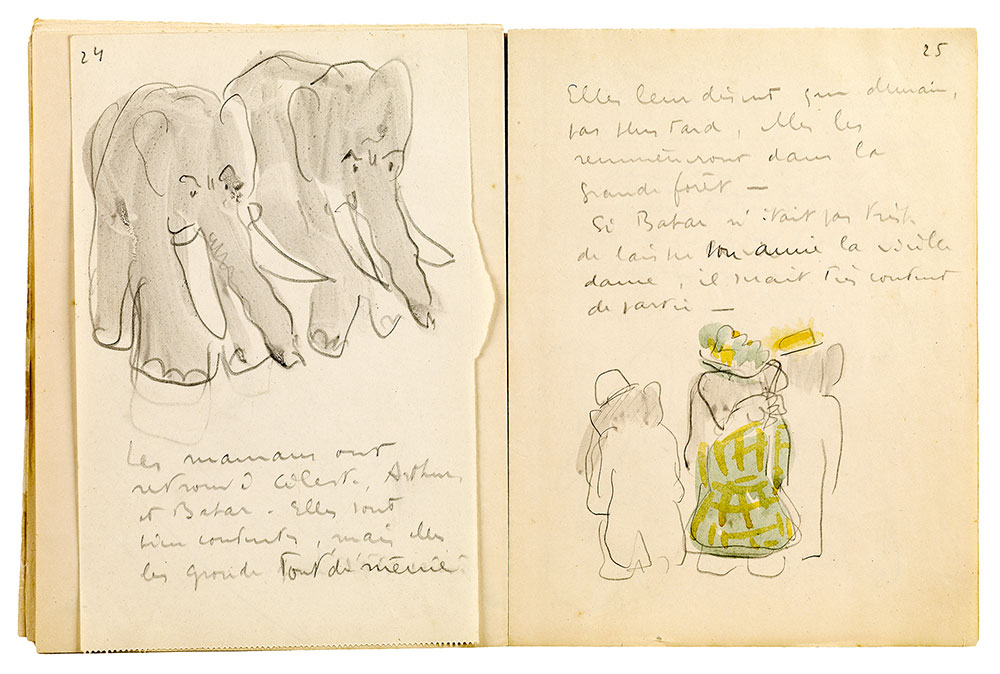
Histoire de Babar, le petit éléphant (The Story of Babar), Maquette
Gift of Laurent, Mathieu, and Thierry de Brunhoff, and purchased with the assistance of The Florence Gould Foundation and the Acquisitions Fund, Fellows Endowment Fund, Gordon N. Ray Fund, and the Heineman Fund, 2004
Les mamans ont retrouvé Céleste, Arthur, et Babar. Elles sont bien contentes, mais elles le gronde[nt] tout de même. / Elles leur disent que demain, pas plus tard, elles les remmèneront dans la grande forêt. Si Babar n'était pas triste de laisser la vie[ille] son amie la vieille dame, il serait très content de partir.
The mothers have found Celeste, Arthur, and Babar. They are very happy but scold them just the same. / They tell them that tomorrow, no later, they will take them back to the great forest. If Babar were not sad about leaving the O[ld] his friend, the Old Lady, he would be very glad to be going.
Les mamans ont retrouvé Céleste, Arthur, et Babar. Elles sont bien contentes, mais elles le gronde[nt] tout de même. / Elles leur disent que demain, pas plus tard, elles les remmèneront dans la grande forêt. Si Babar n'était pas triste de laisser la vie[ille] son amie la vieille dame, il serait très content de partir.
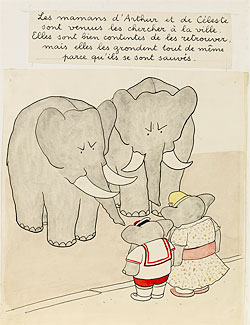
Les mamans d'Arthur et de Céleste sont venues les chercher à la ville. Elles sont bien contentes de les retrouver, mais elles les grondent tout de même parce qu'ils se sont sauvés.
The mothers of Arthur and Celeste have come to the town to fetch them. They are very happy to have them back, but they scold them just the same because they ran away.
Pages 26–27
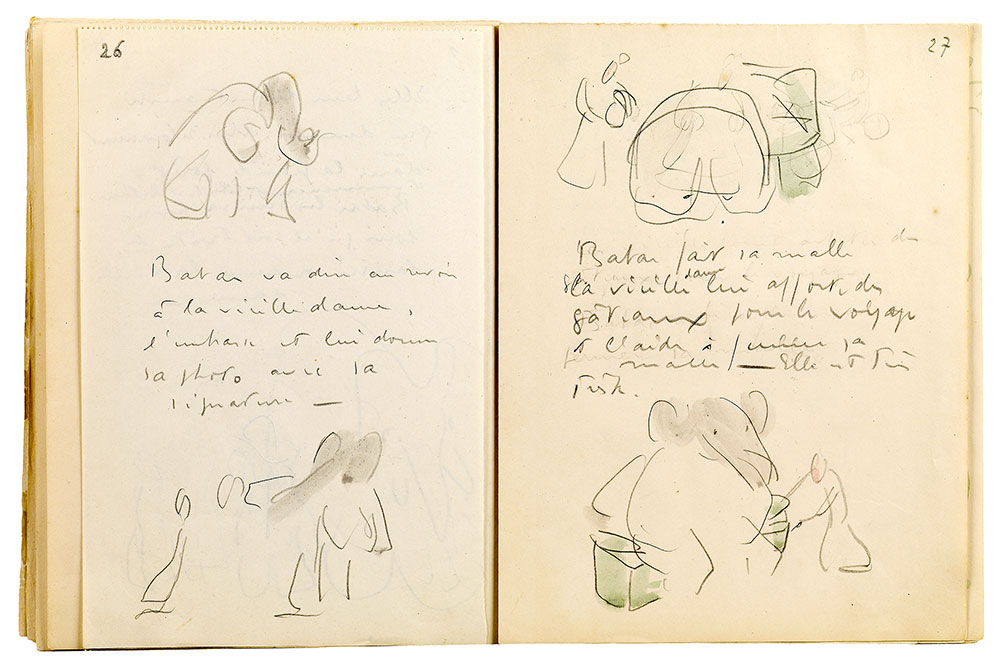
Histoire de Babar, le petit éléphant (The Story of Babar), Maquette
Gift of Laurent, Mathieu, and Thierry de Brunhoff, and purchased with the assistance of The Florence Gould Foundation and the Acquisitions Fund, Fellows Endowment Fund, Gordon N. Ray Fund, and the Heineman Fund, 2004
Babar goes to say good-bye to the Old Lady, kisses her, and gives her his signed photograph. / Babar packs his trunk. The Old Lady brings him some cookies for the trip and helps him close his trunk. She is very sad.
Babar va dire au revoir à la vieille dame, l'embrasse et lui donne sa photo avec sa signature. / Babar fait sa malle. La vieille dame lui apporte des gâteaux pour le voyage et l'aide à fermer sa malle. Elle est très triste.
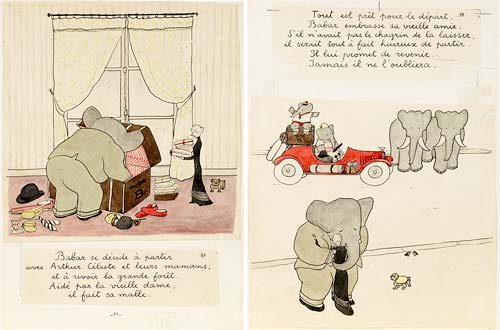
Babar se décide à partir avec Arthur, Céleste et leurs mamans, et à revoir la grande forêt. Aidé par la vieille dame, il fait sa malle. / Tout est prêt pour le départ. Babar embrasse sa vieille amie. S'il n'avait pas le chagrin de la laisser, il serait tout à fait heureux de partir. Il lui promet de revenir. Jamais il ne l'oubliera.
Babar makes up his mind to go back with Arthur and Celeste and their mothers to see the great forest again. The Old Lady helps him to pack his trunk. / Everything is ready for their departure. Babar kisses his old friend. He would be quite happy to go if it were not for leaving her. He promises to come back some day. He will never forget her.
Pages 28–29
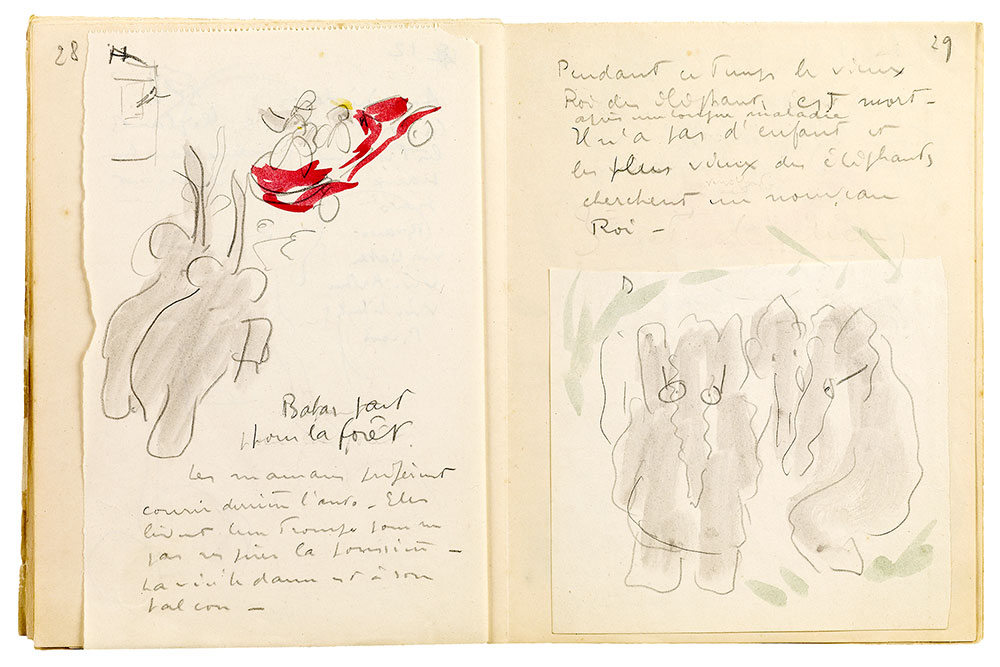
Histoire de Babar, le petit éléphant (The Story of Babar), Maquette
Gift of Laurent, Mathieu, and Thierry de Brunhoff, and purchased with the assistance of The Florence Gould Foundation and the Acquisitions Fund, Fellows Endowment Fund, Gordon N. Ray Fund, and the Heineman Fund, 2004
Babar part pour la forêt. Les mamans préfèrent courir derrière l'auto. Elles lèvent leur trompe pour ne pas respirer la poussière. La vieille dame est à son balcon. / Pendant ce temps le vieux Roi des éléphants est mort après une longue maladie. Il n'a pas d'enfant et les plus vieux des éléphants cherchent un nouveau Roi.
Babar sets out for the forest. The mothers prefer to run behind the car. They lift up their trunks to avoid breathing in the dust. The Old Lady is on her balcony. / Meanwhile, the old elephant king died after a long illness. He does not have children, so the oldest elephants are looking for a new king.
Babar part pour la forêt. Les mamans préfèrent courir derrière l'auto. Elles lèvent leur trompe pour ne pas respirer la poussière. La vieille dame est à son balcon. / Pendant ce temps le vieux Roi des éléphants est mort après une longue maladie. Il n'a pas d'enfant et les plus vieux des éléphants cherchent un nouveau Roi.
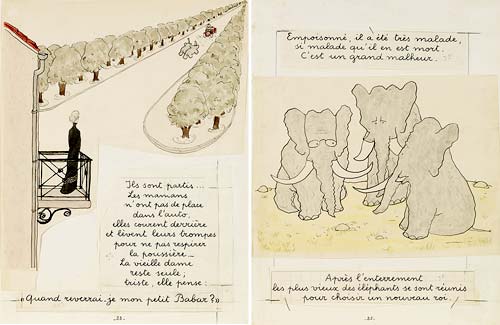
Ils sont partis. . . . Les mamans n'ont pas de place dans l'auto, elles courent derrière et lèvent leur trompe pour ne pas respirer la poussière. La vieille dame reste seule; triste, elle pense: « Quand reverrai-je mon petit Babar? » / [On an added page: Le même jour hélas, le roi des éléphants a mangé un mauvais champignon.] / Empoisonné, il a été très malade, si malade qu'il en est mort. C'est un grand malheur. / Après l'enterrement les plus vieux des éléphants se sont réunis pour choisir un nouveau roi.
They have gone. . . . There is no room in the car for the mothers, so they run behind, and lift up their trunks to avoid breathing the dust. The Old Lady is left alone. Sadly she wonders: "When shall I see my little Babar again?" / [On an added page: Alas, that very day, the king of the elephants has eaten a bad mushroom.] / It poisoned him, and he became ill, so ill that he died. This was a great calamity. / After the funeral the oldest elephants held a meeting to choose a new king.
Pages 30–31
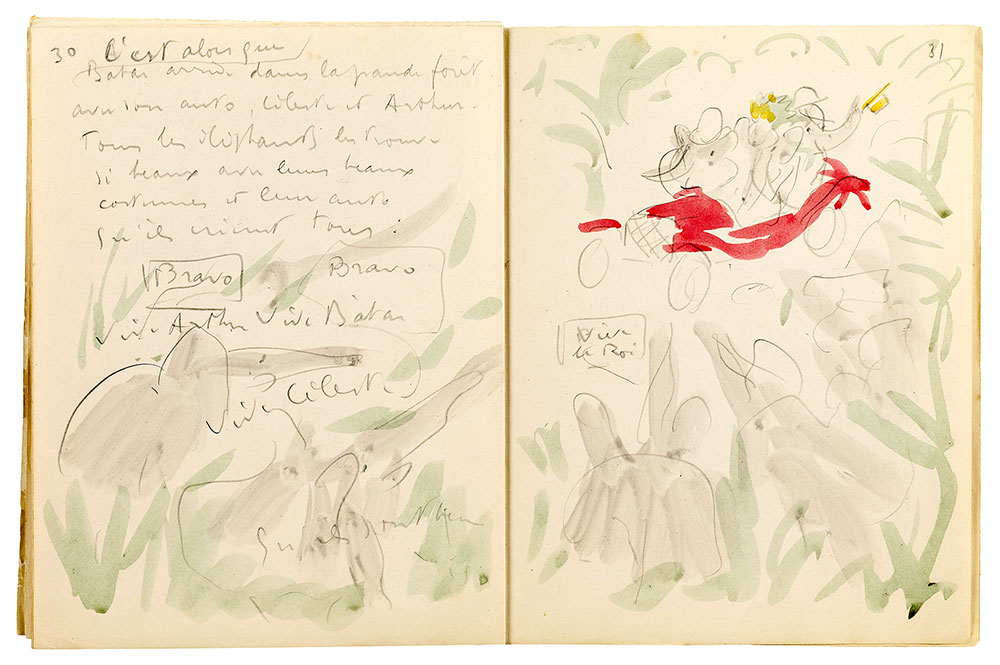
Histoire de Babar, le petit éléphant (The Story of Babar), Maquette
Gift of Laurent, Mathieu, and Thierry de Brunhoff, and purchased with the assistance of The Florence Gould Foundation and the Acquisitions Fund, Fellows Endowment Fund, Gordon N. Ray Fund, and the Heineman Fund, 2004
Just then Babar arrives in the great forest with his car, Celeste, and Arthur. All the elephants think they look so nice in their fine clothes and their car that they all shout: "Bravo / Bravo / Long live Arthur / Long live Babar / Long live Celeste / Don't they look wonderful / Long live the king"
C'est alors que Babar arrive dans la grande forêt avec son auto, Céleste et Arthur. Tous les éléphants les trouve[nt] si beaux avec leurs beaux costumes et leur auto qu'ils crient tous: "Bravo / Bravo / Vive Arthur / Vive Babar / Vive Céleste / Qu'ils sont beaux / Vive le Roi"
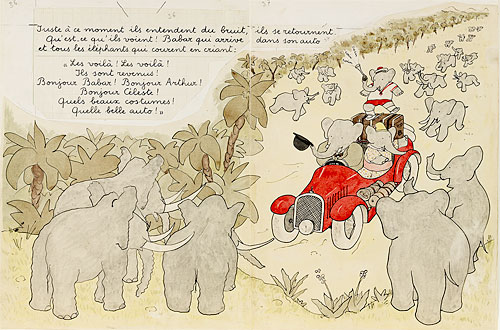
Juste à ce moment ils entendent du bruit, ils se retournent. Qu'est-ce qu'ils voient! Babar qui arrive dans son auto et tous les éléphants qui courent en criant: « Les voilà! Les voilà! Ils sont revenus! Bonjour Babar! Bonjour Arthur! Bonjour Céleste! Quels beaux costumes! Quelle belle auto! »
Just then they hear a noise. They turn around. Guess what they see! Babar arriving in his car and all the elephants running and shouting: "Here they are! Here they are! They have returned! Hello, Babar! Hello, Arthur! Hello, Celeste! What beautiful clothes! What a beautiful car!"
Pages 32–33
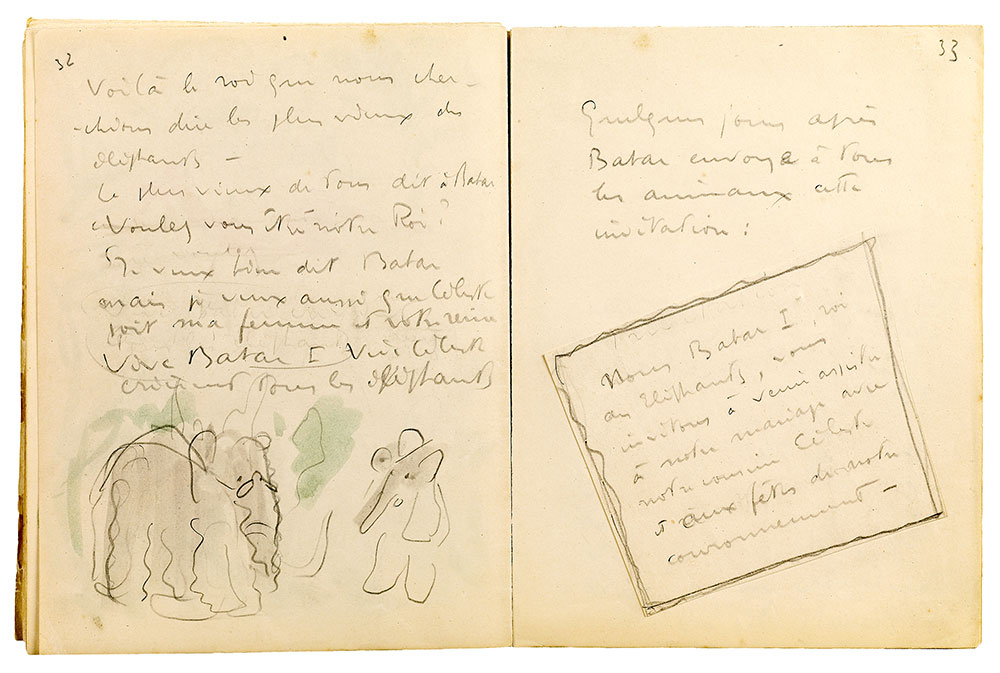
Histoire de Babar, le petit éléphant (The Story of Babar), Maquette
Gift of Laurent, Mathieu, and Thierry de Brunhoff, and purchased with the assistance of The Florence Gould Foundation and the Acquisitions Fund, Fellows Endowment Fund, Gordon N. Ray Fund, and the Heineman Fund, 2004
"Here is the king we have been searching for," say the oldest elephants. The oldest one of all says to Babar, "Would you like to be our King?" "I would like that very much," says Babar, "but I would also like Celeste to be my wife and your queen." "Long live Babar I, Long live Celeste," all the elephants shouted. / A few days later Babar sends this invitation to all the animals: "We, Babar I, king of the elephants, invite you to attend our marriage to our cousin Celeste and our coronation festivities."
"Voilà le roi que nous cherchions" dire[nt] les plus vieux des éléphants. Le plus vieux de tous dit à Babar "Voulez vous être notre Roi?" "Je veux bien, dit Babar, mais je veux aussi que Céleste soit ma femme et votre reine." "Vive Babar I Vive Céleste" crièrent tous les éléphants. / Quelques jours après Babar envoye [i.e., envoie] à tous les animaux cette invitation: "Nous Babar I, roi des éléphants, vous invitons à venir assister à notre mariage avec notre cousine Céleste et aux fêtes de notre couronnement."

Alors Cornélius le plus vieux des éléphants dit de sa voix tremblante: "Mes bons amis, nous cherchons un roi, pourquoi ne pas choisir Babar? Il revient de la ville, il a beaucoup appris chez les hommes. Donnons lui la couronne." Tous les éléphants trouvent que Cornélius a très bien parlé. Impatients, ils attendent la réponse de Babar. / "Je vous remercie tous, dit alors ce dernier, mais avant d'accepter, je dois vous dire que, pendant notre voyage en auto, Céleste et moi nous nous sommes fiancés. Si je suis votre roi, elle sera votre reine." / " Vive la reine Céleste! / Vive le roi Babar!!!" crient tous les éléphants sans hésiter. Et c'est ainsi que Babar devint roi.
Then Cornelius, the oldest of all the elephants, says in his quavering voice: "My good friends, we are seeking a king. Why not choose Babar? He has just returned from the city, he has learned so much living among men, let us give him the crown." All the other elephants think that Cornelius has spoken wisely, and they eagerly await Babar's reply. / "I want to thank you one and all," said Babar, "but before accepting your proposal, I must explain to you that, while we were traveling in the car, Celeste and I became engaged. If I become your king, she will be your queen." / "Long live Queen Celeste! Long live King Babar!!!" cry all the elephants without a moment's hesitation. And thus it was that Babar became king.
Pages 34–35
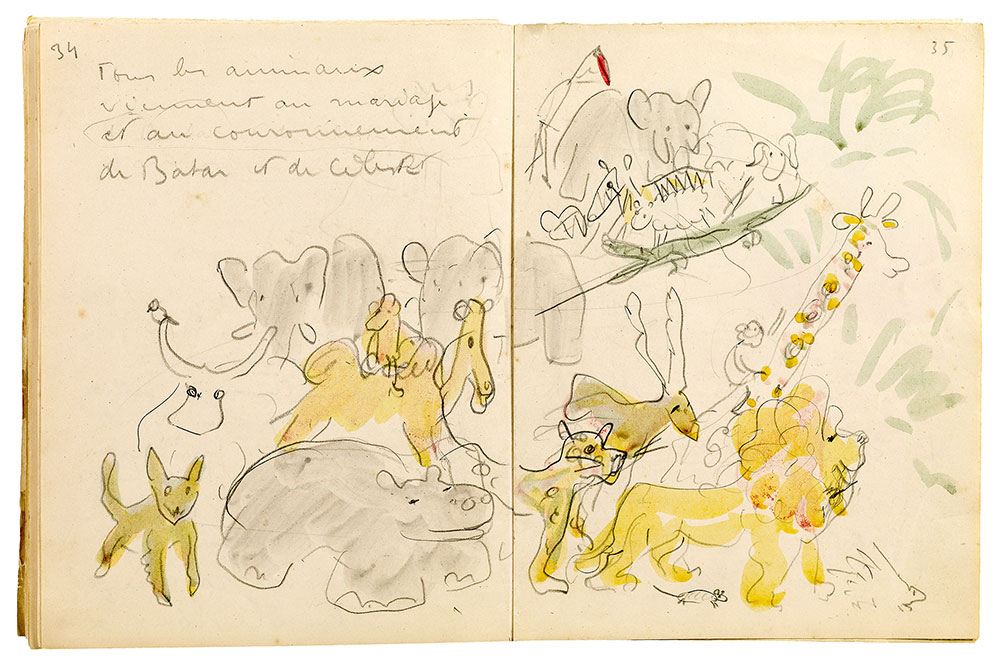
Histoire de Babar, le petit éléphant (The Story of Babar), Maquette
Gift of Laurent, Mathieu, and Thierry de Brunhoff, and purchased with the assistance of The Florence Gould Foundation and the Acquisitions Fund, Fellows Endowment Fund, Gordon N. Ray Fund, and the Heineman Fund, 2004
All the animals come to the marriage and coronation of Babar and Celeste.
Tous les animaux viennent au mariage et au couronnement de Babar et de Céleste.
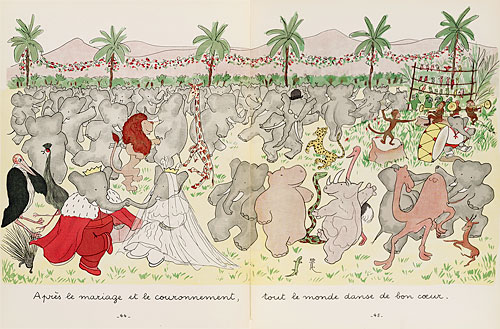
Après le mariage et le couronnement, tout le monde danse de bon coeur.
After the wedding and the coronation everybody dances merrily.
Pages 36–37
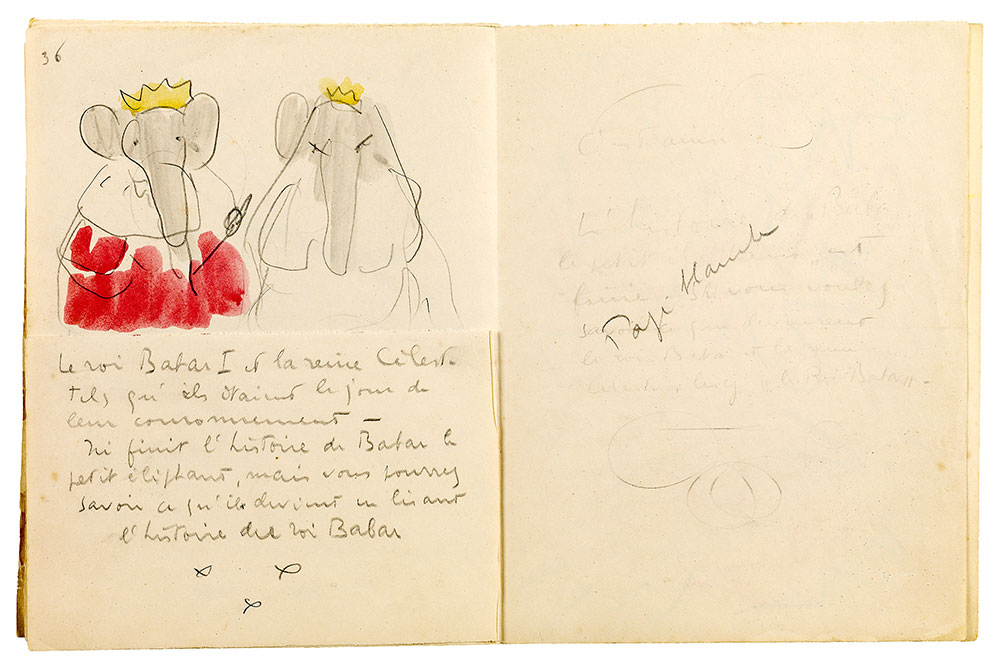
Histoire de Babar, le petit éléphant (The Story of Babar), Maquette
Gift of Laurent, Mathieu, and Thierry de Brunhoff, and purchased with the assistance of The Florence Gould Foundation and the Acquisitions Fund, Fellows Endowment Fund, Gordon N. Ray Fund, and the Heineman Fund, 2004
King Babar I and Queen Celeste as they looked the day of their coronation. Here ends the story of Babar the little elephant, but you can find out what happens to him if you read the story of Babar the King.
Le roi Babar I et la reine Céleste tels qu'ils étaient le jour de leur couronnement. Ici finit l'histoire de Babar le petit éléphant, mais vous pourrez savoir ce qu'il devient en lisant l'histoire du roi Babar.
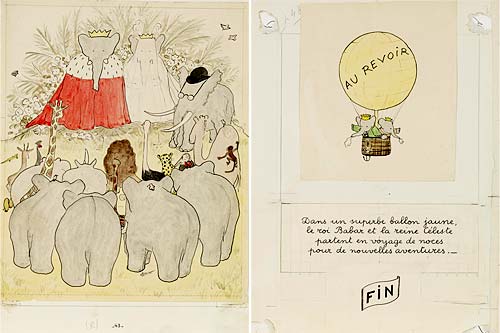
Dans un superbe ballon jaune, le roi Babar et la reine Céleste partent en voyage de noces pour de nouvelles aventures.
In a gorgeous yellow balloon, King Babar and Queen Celeste set out on their honeymoon for further adventures.
Back endpaper
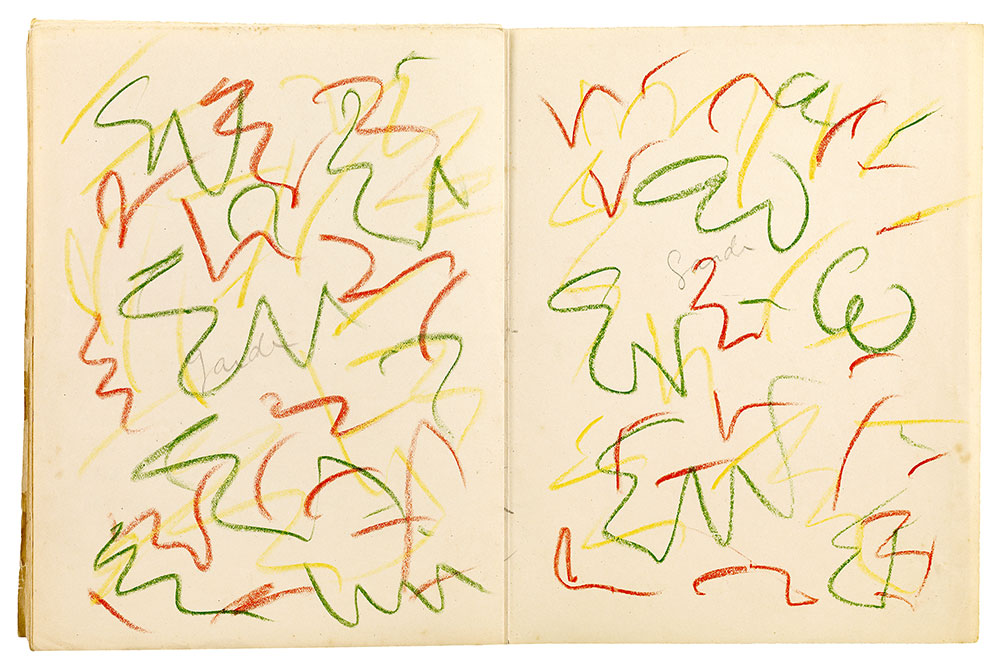
Histoire de Babar, le petit éléphant (The Story of Babar), Maquette
Gift of Laurent, Mathieu, and Thierry de Brunhoff, and purchased with the assistance of The Florence Gould Foundation and the Acquisitions Fund, Fellows Endowment Fund, Gordon N. Ray Fund, and the Heineman Fund, 2004
These rear endpapers repeat the design that appears on the second set of front endpapers. Once again, Jean de Brunhoff used the limited palette—green, red, and yellow—that he had chosen for the book's illustrations. These pages of the maquette were not incorporated in the published edition.
Back cover
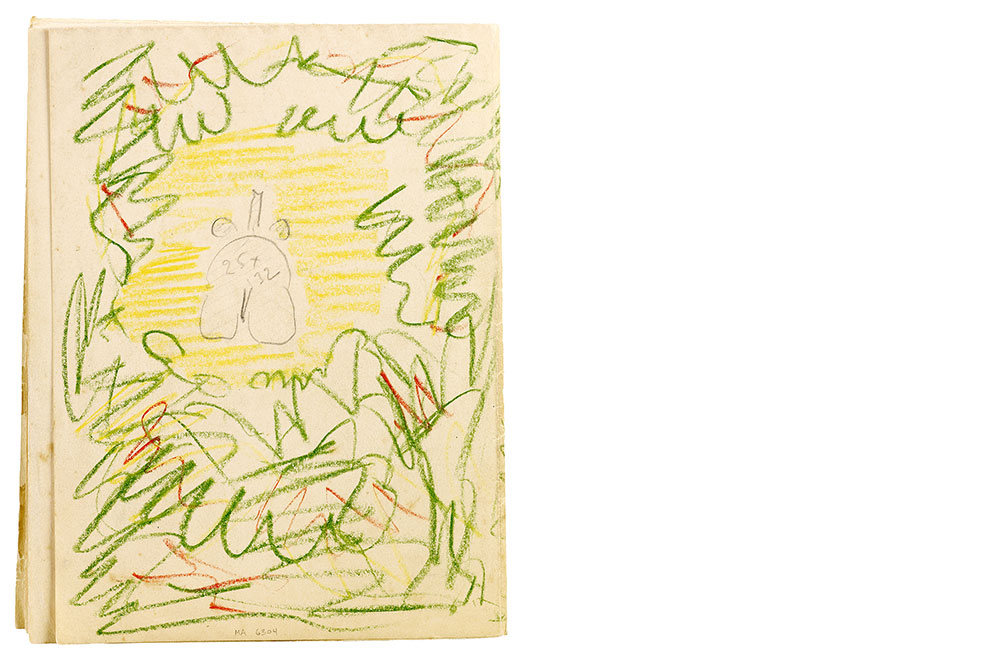
Histoire de Babar, le petit éléphant (The Story of Babar), Maquette
Gift of Laurent, Mathieu, and Thierry de Brunhoff, and purchased with the assistance of The Florence Gould Foundation and the Acquisitions Fund, Fellows Endowment Fund, Gordon N. Ray Fund, and the Heineman Fund, 2004
The maquette features a fully frontal Babar on the front cover and a rear view (looking much like an elephant backside by Toulouse-Lautrec) on the back cover. Inside the rear elephant form, Jean de Brunhoff wrote 25 x 32, apparently a proposed page size in centimeters. (The printed pages would be slightly larger at 26.5 centimeters wide and 36.3 high.) This design was not incorporated in the published edition; The Story of Babar has a plain red back cover without illustration.